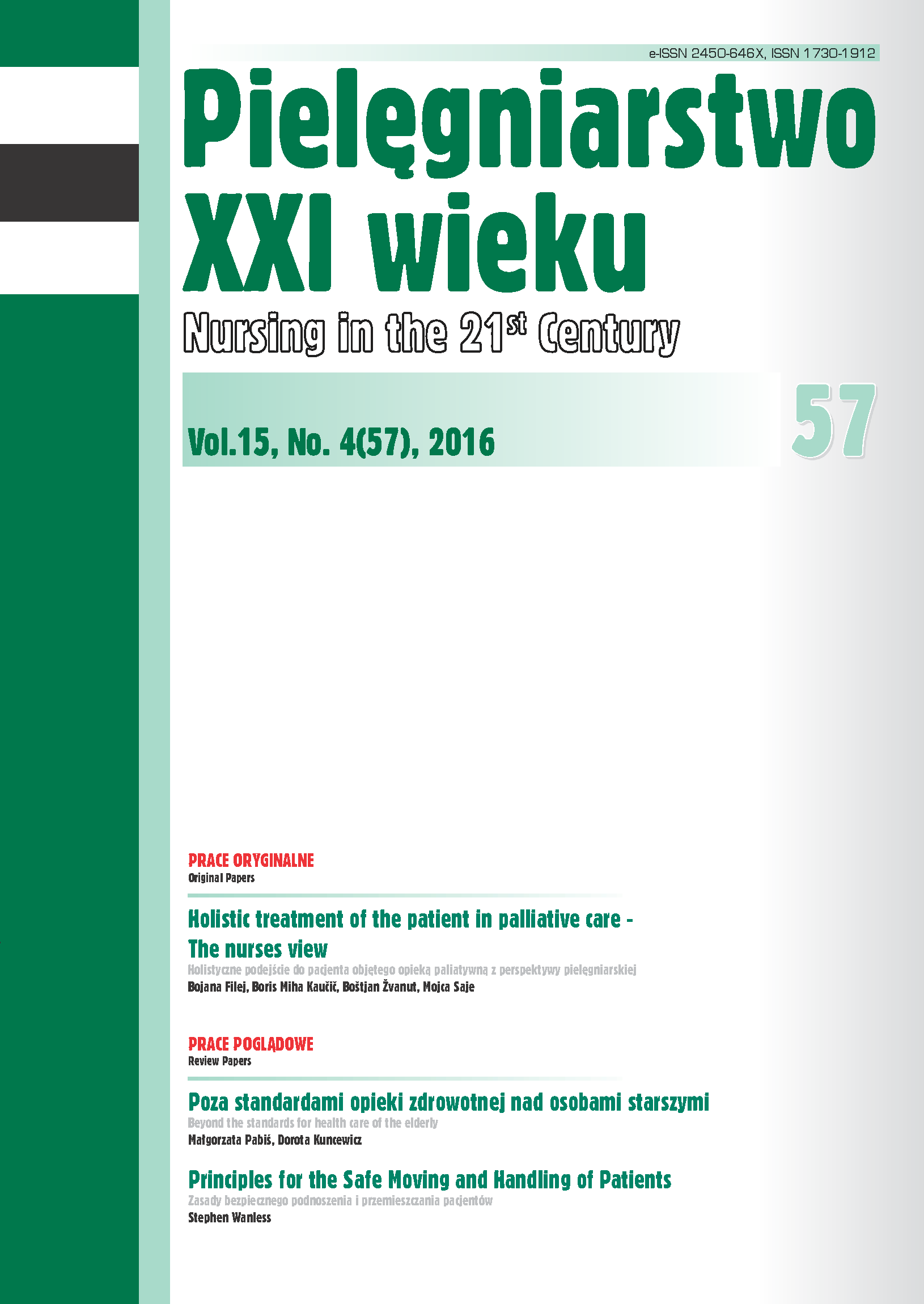Zasady bezpiecznego podnoszenia i przemieszczania pacjentów
DOI:
https://doi.org/10.1515/pielxxiw-2016-0040Słowa kluczowe:
postawa, uraz układu mięśniowo-szkieletowego, mechanika ciała, podnoszenie i przemieszczanieAbstrakt
POZA STANDARDAMI OPIEKI ZDROWOTNEJ NAD OSOBAMI STARSZYMI
Sposób poruszania się człowieka podczas chodzenia czy biegania jest częstym przedmiotem badań naukowych. Stwierdzono jednak zwiększoną częstość występowania urazów narządu ruchu spowodowanych nieodpowiednim podnoszeniem i przemieszczaniem pacjentów przez pracowników służby zdrowia. Jest to jedna z głównych przyczyn długotrwałych problemów układu mięśniowoszkieletowego. W obszarze klinicznym układ ten ulega obciążeniom mechanicznym, zwiększając tym samym ograniczenia związane z naprężeniem i napięciem ciała, a gdy ograniczenia te zostają przekroczone, wtedy następuje uraz. Ryzyko bólu i urazu ma bezpośredni związek z nadużywaniem nieodpowiedniej pozycji przy podnoszeniu i przemieszczaniu pacjentów, co z kolei może prowadzić do utraty przez nich sił i zmniejszenia funkcji układu mięśniowo-szkieletowego. Sytuacja ta może ulec zmianie poprzez dostosowanie bezpiecznych biomechanicznych sposobów przemieszczania ciała pacjenta przez pracowników służby zdrowia.
Bibliografia
1. Dorn TW, Wang JM, Hicks JL, Delp SL. Predictive Simulation Generates Human Adaptations during Loaded and Inclined Walking. Public Library of Science One. 2015; 10: 4.
2. Asgari M, Sanjari MA, Mokhtarini HR, et al. The effects of movement speed on kinematic variability and dynamic stability of the trunk in healthy individuals and low back pain patients. Clinical Biomechanics. 2015; 30 (7): 682-688.
3. Wanless S. Improving the effectiveness of motor skills learning in moving and handling training for the healthcare environment. Unpublished PhD thesis, 2015.
4. Health and Safety Executive. Work Related Musculoskeletal Disorder statistics, Great Britain 2015. HMSO. London, 2015.
5. Wanless S. Hopper D. Moving and Handling Practice: The Challenge for Educators. Equipment Services Journal. 2015; 7: 44-48.
6. June KJ. Cho S. Low back pain and work-related factors among nurses in intensive care units. Journal of Clinical Nursing. 2011; 20:3-4: 479-487.
7. Castro AB. Handle with Care: The American Nurses Association’s Campaign to Address Work-Related Musculoskeletal Disorders. Orthopaedic Nursing. 2006; 25 (6): 356-365.
8. de Souza Petersen R, Marziale MHP. Low back pain characterized by muscle resistance and occupational factors associated with nursing. Revista Latino- Americana de Enfermagem. 2014; 22 (3): 386-393.
9. Lind A, Gard G. Harmful Effects in Personal Assistants’ Client Transfer Situations. The Ergonomics Open Journal. 2014; 7: 1-5.
10. Bonzini M, Bertu’ L, Veronesi G, et al. Is musculoskeletal pain a consequence or a cause of occupational stress? A longitudinal study. International Archives of Occupational and Environmental Health. 2015; 88(5): 607-612.
11. Hignett S. Intervention strategies to reduce musculoskeletal injuries associated with handling patients: a systematic review. Occupational and Environmental Medicine. 2003; 60: E6.
12. Bevan S. Economic impact of musculoskeletal disorders (MSDs) on work in Europe. Best Practice & Research Clinical Rheumatology. 2015; 29(3): 356–373.
13. Parent-Thirion A, Vermeylen G, van Houten G, et al. Eurofound project: Fifth European Working Conditions Survey. The European Foundation for the Improvement of Living and Working Conditions. Luxembourg, 2012.
14. Smedley J, Williams S, D’Arcy P, et al. Back pain management: Occupational health practice in the NHS in England. A national clinical audit – round 2. London: Royal College of Physicians, 2012.
15. Unison. UNISON submission to the NHS Working Longer Review. London: Unison, 2013.
16. Wanless S. and Wanless SG. Hoisting a patient: Principles for safer practice. International Journal of Therapy and Rehabilitation. 2015; 22(8): 390- 395.
17. Health and Safety Commission. Manual Handling Operations Regulations 1992, L23 (as amended 2004). HMSO. London, 2016.
Opublikowane
Numer
Dział
Licencja
Prawa autorskie (c) 2016 Autor

Praca jest udostępniana na licencji Creative Commons Attribution-NonCommercial-NoDerivatives 3.0 Unported License.




